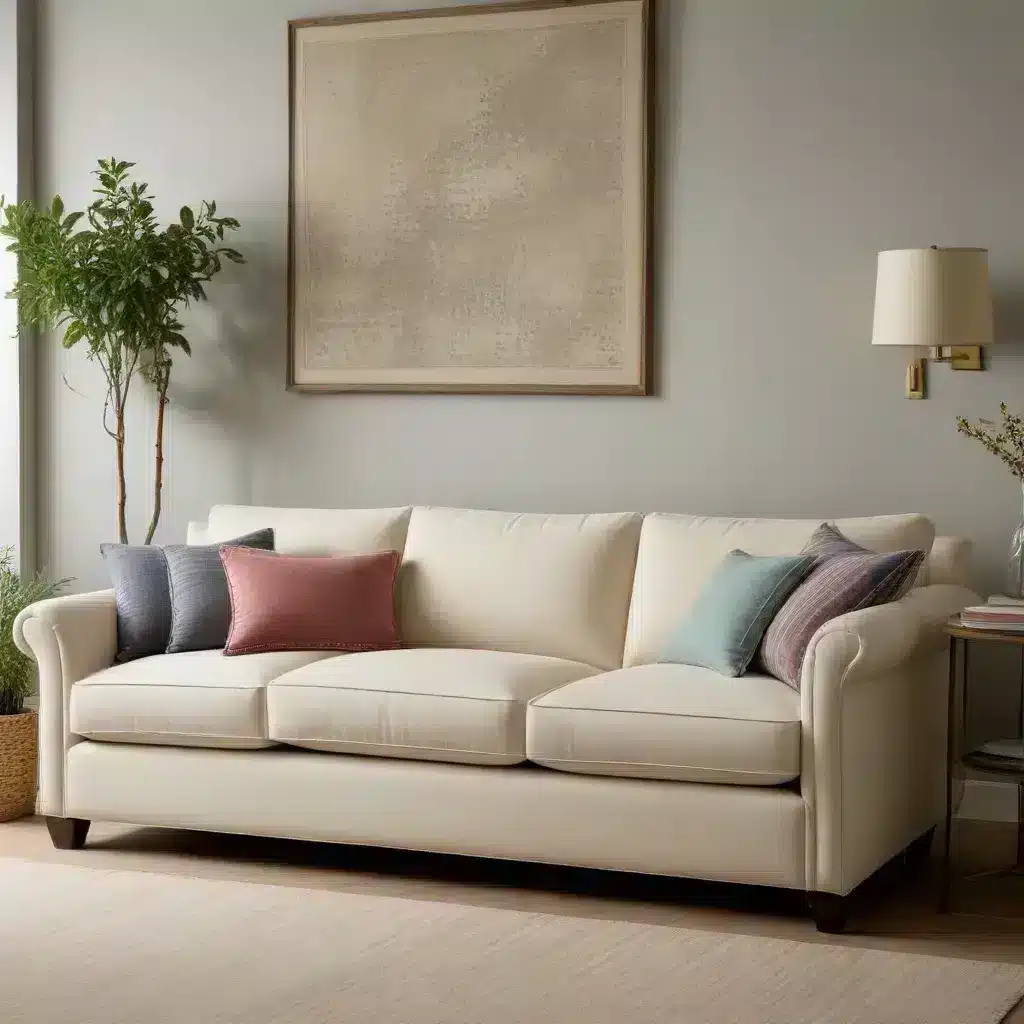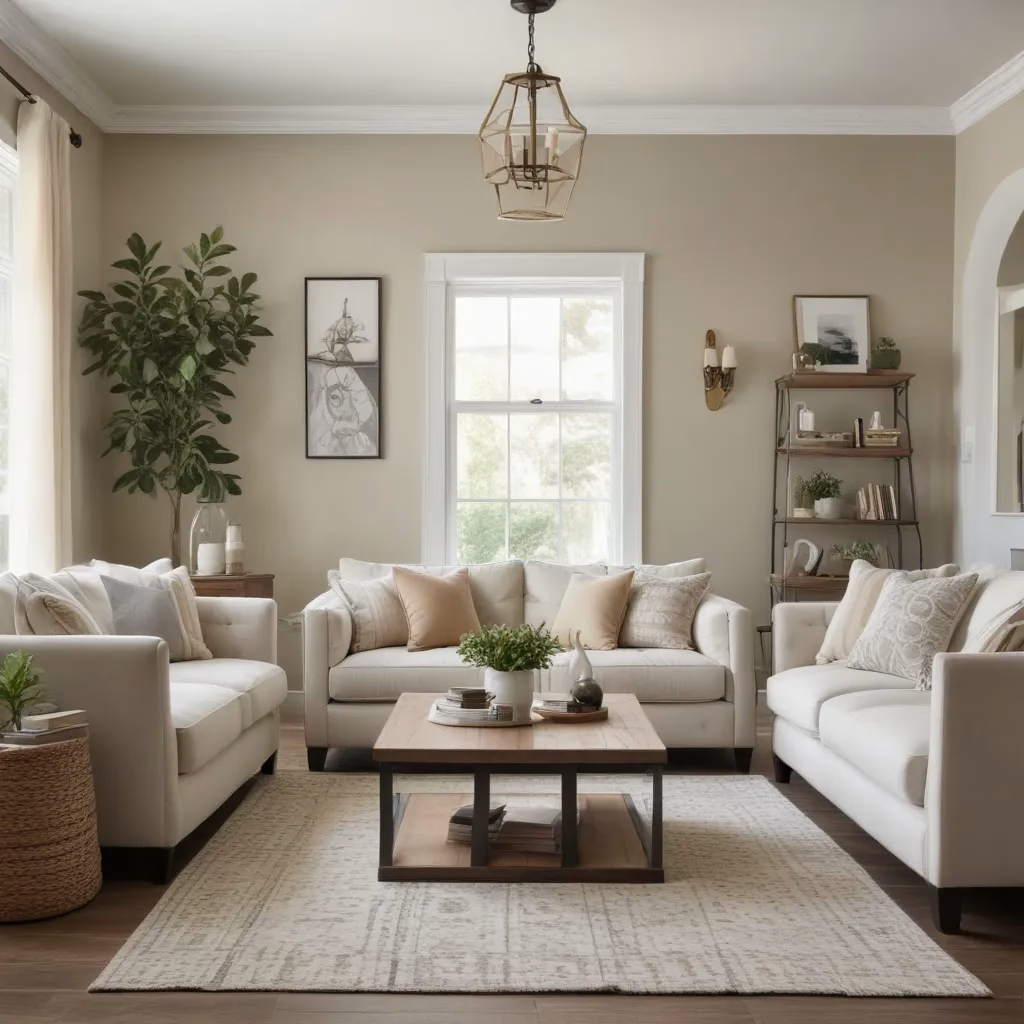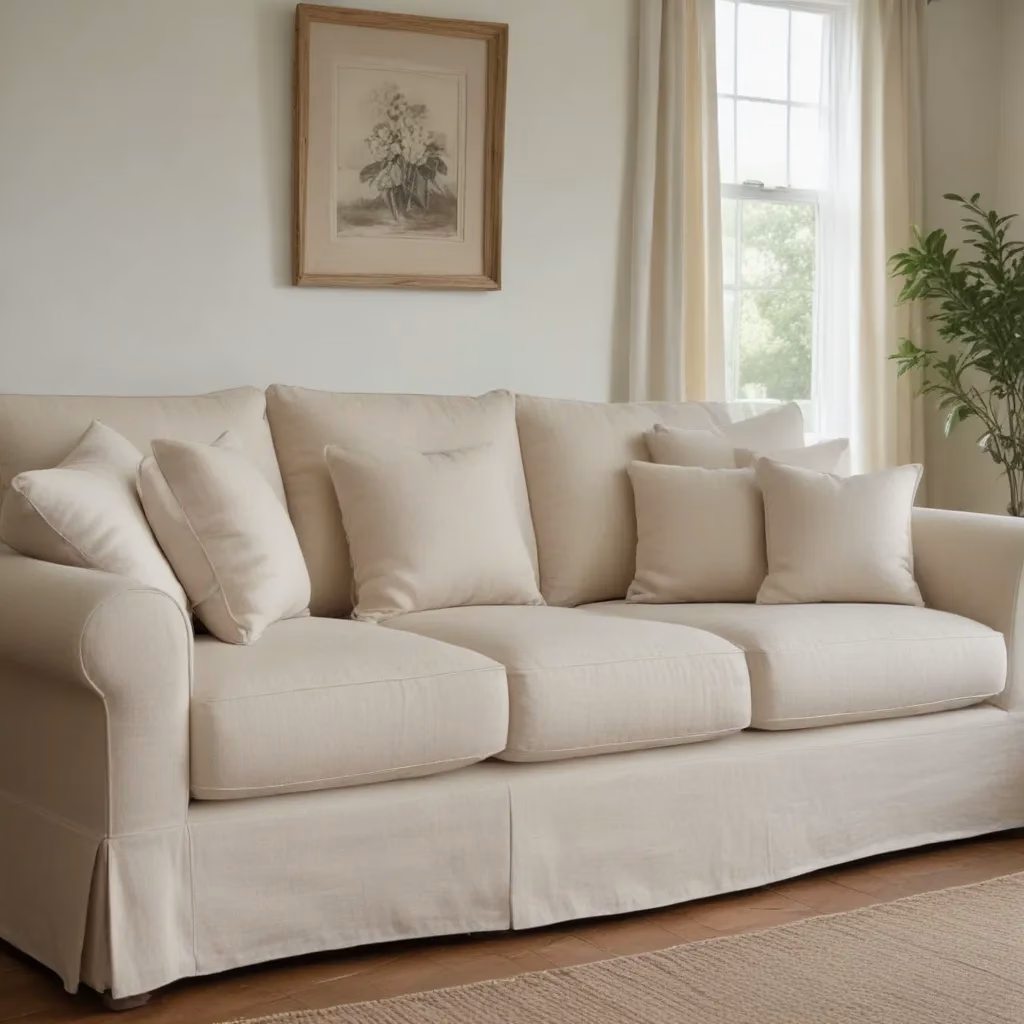
The Art of Sofa Selection: Balancing Form and Function
When it comes to furnishing your living space, few pieces carry as much weight as the humble sofa. It’s not just a place to sit; it’s the centerpiece of your living room, the stage for countless conversations, and your personal retreat after a long day. As a furniture specialist, I’ve seen firsthand how the right sofa can transform a room and enhance daily life.
Selecting the ideal sofa is a delicate balance of aesthetics and practicality. You want a piece that catches the eye and complements your decor, but it also needs to withstand the rigors of daily use. I always tell my clients to consider their lifestyle first. Are you a family with young children and pets? You’ll need durable, stain-resistant fabrics. Do you love to host movie nights? Look for deep seats and plush cushions.
One aspect that’s often overlooked is the sofa’s scale in relation to your room. I’ve walked into many homes where an oversized sectional overwhelms the space, or a petite loveseat gets lost in a grand living room. Always measure your space carefully, and don’t forget to account for traffic flow around the sofa. A good rule of thumb is to leave at least 18 inches of walking space around the perimeter.
Understanding Sofa Construction: The Backbone of Comfort
The old adage “you get what you pay for” rings especially true in the world of sofas. While it’s tempting to opt for a budget-friendly option, investing in quality construction pays dividends in longevity and comfort. Let’s break down the key components of a well-made sofa:
Frame Fundamentals
The frame is the skeleton of your sofa, and its quality will determine how well the piece holds up over time. In my experience, hardwood frames, particularly those made from kiln-dried oak, maple, or beech, offer the best durability. These woods resist warping and cracking, ensuring your sofa maintains its shape for years to come.
Avoid frames made from particleboard or MDF, as these materials can break down quickly, especially in high-use areas. When examining a sofa, give it a lift from one corner. If it flexes or creaks, that’s a red flag indicating a weak frame.
Suspension Systems: The Unsung Heroes
The suspension system is what gives your sofa its bounce and support. There are several types, each with its own pros and cons:
-
Eight-way hand-tied springs: This is the gold standard in sofa suspension. Craftsmen tie each spring to the adjacent springs in eight directions, creating a network that distributes weight evenly and prevents sagging.
-
Sinuous springs: These S-shaped wires run from front to back of the seat. They’re less expensive than hand-tied springs but can still provide good support if properly installed.
-
Web suspension: Made from elastic bands stretched across the frame, this is the most budget-friendly option. It can be comfortable initially but tends to sag over time.
In my years of experience, I’ve found that sofas with eight-way hand-tied springs or high-quality sinuous springs offer the best long-term comfort and durability.
Cushion Composition: The Comfort Factor
Cushions are where personal preference really comes into play. Some people love a firm seat, while others prefer to sink into cloud-like softness. Here are the most common cushion fill options:
-
High-resilience foam: Offers a firm, supportive seat that maintains its shape well.
-
Down-wrapped foam: Combines the support of foam with the softness of down for a luxurious feel.
-
Polyester fiber: An affordable option that’s hypoallergenic but can flatten quickly.
-
Down and feather blend: Extremely soft and comfortable but requires regular fluffing to maintain shape.
I often recommend a combination of materials for the best of both worlds. For example, a high-resilience foam core wrapped in a layer of down can provide both support and softness.
Upholstery Options: Dressing Your Sofa for Success
The upholstery is the face of your sofa, and it plays a crucial role in both aesthetics and functionality. When advising clients, I always stress the importance of choosing a fabric that not only looks good but can stand up to their lifestyle.
Natural Fibers: Timeless Beauty with a Caveat
Natural fibers like cotton, linen, and wool have an undeniable appeal. They’re breathable, comfortable, and often have a lovely texture. However, they can be less durable and more prone to staining than synthetic options. If you’re set on a natural fiber, look for treated fabrics that offer some stain resistance.
Synthetic Fabrics: Durability Meets Design
Polyester, nylon, and acrylic fabrics have come a long way in recent years. Many now mimic the look and feel of natural fibers while offering superior durability and stain resistance. For busy households, I often recommend a high-performance synthetic fabric that can withstand spills, pet claws, and heavy use.
Leather: A Luxurious Investment
Leather sofas are a timeless choice that can actually improve with age. They’re incredibly durable and easy to clean, making them ideal for families. However, leather does require some maintenance to prevent cracking and fading. It’s also important to note that not all leather is created equal. Full-grain leather is the highest quality and most durable, while bonded leather (made from scraps) should be avoided as it tends to peel over time.
Performance Fabrics: The Best of Both Worlds
In recent years, performance fabrics have revolutionized the upholstery industry. These engineered textiles offer the aesthetics of high-end fabrics with unparalleled durability and stain resistance. They’re an excellent choice for households with children or pets, or for anyone who wants to enjoy their sofa without worrying about every little spill.
When selecting upholstery, always request fabric samples to test at home. Look at them under different lighting conditions and feel the texture. For durability, check the double rub count—a measure of abrasion resistance. A count of 15,000 is good for light use, while 30,000 or higher is suitable for heavy use.
Sofa Styles: Finding Your Perfect Match
The style of your sofa sets the tone for your entire living space. As a furniture specialist, I’ve helped countless clients navigate the sea of options to find their ideal match. Here’s a rundown of some popular styles and who they might suit best:
Mid-Century Modern: Sleek and Sophisticated
Characterized by clean lines, tapered legs, and minimalist design, mid-century modern sofas are perfect for those who appreciate a retro-inspired look. These sofas often feature tufted backs and come in bold colors or rich leather. They work well in smaller spaces and complement a variety of decor styles.
Chesterfield: Timeless Elegance
The Chesterfield sofa, with its distinctive rolled arms, deep button tufting, and equal back and arm height, exudes classic charm. It’s an excellent choice for traditional or vintage-inspired interiors. While traditionally upholstered in leather, modern Chesterfields come in a variety of fabrics to suit different tastes.
Sectional: Versatile and Spacious
Sectional sofas are the ultimate in flexibility. They can be configured to fit your space perfectly and offer ample seating for large families or frequent entertainers. L-shaped and U-shaped sectionals are popular choices, but modular designs allow for even more customization.
Lawson: Casual Comfort
The Lawson sofa is all about comfort. With its boxy shape, loose back pillows, and simple lines, it’s a versatile choice that works in both casual and formal settings. The separate back cushions make it easy to adjust for your preferred level of support.
Tuxedo: Sophisticated Simplicity
Named for its resemblance to a tuxedo jacket, this style features arms the same height as the back, creating a sleek, boxy silhouette. Tuxedo sofas often have a tufted back and seat, adding a touch of glamour. They’re ideal for modern or art deco-inspired spaces.
English Roll Arm: Cozy Traditionalism
With its low arms that curve outwards and loose back cushions, the English roll arm sofa strikes a balance between formal and relaxed. It’s often upholstered in a patterned fabric and paired with turned wooden legs, making it a great fit for cottage or traditional interiors.
When choosing a style, consider not just the aesthetics but also how you’ll use the sofa. A deep, plush sectional might be perfect for movie nights, while a more structured tuxedo sofa could be better suited to a formal living room.
Sofa Placement: Maximizing Your Space
Once you’ve selected your perfect sofa, the next challenge is placing it optimally within your room. As someone who’s arranged countless living spaces, I can tell you that proper placement can make or break a room’s flow and functionality.
The Focal Point Approach
In most living rooms, the sofa serves as the focal point. I typically recommend positioning it to face the room’s main feature, whether that’s a fireplace, a picture window with a view, or a media center. This creates a natural gathering spot and sets the stage for the rest of your furniture arrangement.
Traffic Flow Considerations
Always leave enough space for people to move comfortably around the sofa. A minimum of 30 inches is needed for major walkways, but I prefer to allow 36 inches when possible. This ensures that people can pass by without feeling cramped, even when others are seated.
Conversation Areas
If your space allows, consider creating a conversation area by placing two sofas facing each other with a coffee table in between. This arrangement encourages interaction and works well for those who love to entertain. In larger rooms, you might even create multiple seating areas using a combination of sofas, loveseats, and chairs.
Wall Placement vs. Floating
While it’s common to push a sofa against a wall, don’t be afraid to float it in the room. This can create a more dynamic space and is especially effective in open-plan living areas. Just be sure to anchor it with a rug and perhaps a console table behind it to prevent the sofa from feeling adrift.
Scale and Balance
Pay attention to the scale of your sofa in relation to other pieces in the room. A massive sectional can overwhelm a small space, while a petite loveseat might look lost in a grand living room. Aim for a balanced look by mixing different furniture heights and sizes.
Remember, these are guidelines, not hard and fast rules. The best arrangement is one that works for your lifestyle and makes you feel comfortable in your space.
Sofa Care and Maintenance: Preserving Your Investment
A high-quality sofa is an investment, and like any investment, it requires proper care to maintain its value and appearance. Over the years, I’ve developed a set of best practices for sofa maintenance that can significantly extend the life of your furniture.
Regular Cleaning
Vacuum your sofa weekly using the upholstery attachment. This removes dust, crumbs, and other debris that can work their way into the fabric and cause premature wear. For leather sofas, dust with a soft, dry cloth.
Addressing Spills Immediately
The key to preventing stains is quick action. Blot (don’t rub) spills with a clean, white cloth to absorb as much liquid as possible. For water-based spills on fabric upholstery, a mixture of mild soap and warm water can be effective. Always test any cleaning solution on an inconspicuous area first.
Protecting from Sunlight
Direct sunlight can fade and damage upholstery over time. If your sofa is near a window, consider using sheer curtains or UV-protective window film to filter the light. Rotating cushions regularly can also help ensure even fading if some exposure is unavoidable.
Maintaining Shape
Fluff and rotate cushions weekly to maintain their shape and ensure even wear. For sofas with reversible cushions, flip them over every few months. This is especially important for down-filled cushions, which can settle and lose their loft over time.
Professional Cleaning
Even with regular care, sofas benefit from professional cleaning every 12-18 months. This deep clean can remove embedded dirt and refresh the fabric. For leather sofas, consider professional conditioning to keep the leather supple and prevent cracking.
Protecting Against Wear
Use arm covers or throws on areas that receive the most wear, such as armrests and headrests. This is especially useful for leather sofas, which can develop a patina in high-use areas.
Avoiding Overcrowding
Resist the urge to overload your sofa with throw pillows and blankets. While these accessories can add style, too many can put stress on the cushions and seams.
By following these care tips, you can keep your sofa looking fresh and comfortable for years to come. Remember, a well-maintained sofa not only looks better but also provides a more hygienic and enjoyable seating experience for you and your guests.
The Future of Sofa Design: Trends and Innovations
As a furniture specialist, I’m always excited to see how sofa design evolves to meet changing lifestyles and aesthetic preferences. The future of sofa design is shaping up to be an exciting blend of comfort, technology, and sustainability.
Modular and Multifunctional Designs
Flexibility is key in modern homes, and sofa designs are reflecting this trend. Modular sofas that can be rearranged to suit different needs are becoming increasingly popular. These pieces often come with removable arms, adjustable backrests, and even built-in storage compartments.
I’ve seen a rise in sofas that transform into dining tables or workstations, catering to the growing number of people working from home. These multifunctional pieces are especially valuable in smaller urban living spaces where every square foot counts.
Smart Sofas
Technology is making its way into our seating, with smart sofas that offer built-in USB ports, wireless charging pads, and even voice-controlled adjustable headrests and footrests. Some high-end models come with heating and massage functions, turning your living room into a spa-like retreat.
Sustainable Materials
Eco-consciousness is driving innovation in sofa materials. I’m seeing more sofas made from recycled plastics, sustainably sourced wood, and organic fabrics. Some manufacturers are even experimenting with biodegradable foam alternatives made from plant-based materials.
Biophilic Design
The desire to connect with nature is influencing sofa design, with more organic shapes and nature-inspired colors becoming prevalent. Curved sofas that mimic natural forms are gaining popularity, as are upholstery fabrics with botanical prints or textures that mimic natural materials.
Customization
Consumers are increasingly looking for ways to express their individuality through their furniture. Many manufacturers now offer extensive customization options, allowing buyers to choose everything from the arm style and leg finish to the type of cushion fill and fabric pattern.
Health-Focused Features
In the wake of global health concerns, we’re seeing more attention paid to the health aspects of sofa design. Antimicrobial fabrics, hypoallergenic materials, and designs that promote proper posture are becoming more common.
As we look to the future, it’s clear that sofas will continue to evolve beyond mere seating. They’re becoming integrated parts of our smart homes, extensions of our personal style, and reflections of our values. It’s an exciting time to be in the furniture industry, and I can’t wait to see what innovations the next few years will bring.
Making Your Final Decision: Putting It All Together
After exploring all these aspects of sofa selection, you might feel a bit overwhelmed. Don’t worry—I’ve guided countless clients through this process, and I can assure you that finding the perfect sofa is achievable. Here’s how to bring it all together:
Prioritize Your Needs
Make a list of your must-haves. Is comfort your top priority? Do you need a sofa that can withstand the rigors of family life? Are you looking for a statement piece to define your living space? Knowing your priorities will help you make trade-offs if necessary.
Set a Realistic Budget
Quality sofas are an investment, but there are options at various price points. Remember that a well-made sofa can last for decades, so consider the cost per year of use rather than just the upfront price.
Test Before You Buy
Whenever possible, sit on the sofa before making a purchase. Spend at least 10 minutes on it, trying out different positions. If you’re shopping online, check the return policy and make sure you can send the sofa back if it doesn’t meet your expectations.
Consider Your Space
Measure your room carefully and create a floor plan. Consider not just the size of the sofa, but also how it will fit with your other furniture and how it will affect traffic flow in the room.
Think Long-Term
While it’s tempting to choose a sofa based on current trends, consider how it will fit into your life and decor in the years to come. Classic styles and neutral colors tend to have more staying power.
Don’t Forget the Details
Pay attention to the small things that can make a big difference in your day-to-day experience. Things like the height of the arms, the depth of the seat, and the firmness of the cushions can greatly affect your comfort.
Trust Your Instincts
At the end of the day, you’re the one who will be living with this sofa. If a piece speaks to you and meets your practical needs, it’s probably the right choice.
Remember, the perfect sofa is out there waiting for you. With these guidelines in mind, you’re well-equipped to make an informed decision that you’ll be happy with for years to come. Happy sofa hunting!
For more expert advice on creating your perfect living space, visit Sofa Spectacular. We’re here to help you turn your house into a home, one comfortable seat at a time.



